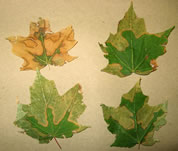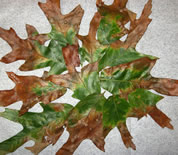Under the Scope Feature
Bacterial Leaf Scorch
August 2013
Bacterial Leaf Scorch is caused by the bacterium Xylella fastidiosa, and it infects several species of deciduous trees. Until recently, there have been few reports of this disease occurring in NYS, but over the past few years several samples received at the Clinic from the southeastern part of the state have tested positive for the presence of this pathogen. In most of these cases, symptoms on infected plants have been highly characteristic of the disease.
American Elm and several species of Oak (bur, laurel, pin, chestnut, black, red, scarlet, shingle, live, white, willow and several others) and maple (red, sugar, boxelder) are known hosts. Additional trees, shrubs and vines have been reported to be susceptible include mulberry, hackberry, sweetgum, oleander, flowering dogwood, and sycamore. In addition, X. fastidiosa causes Pierce’s Disease of grape and scorch diseases of other crop trees such as peach, almond, plum, pear, and coffee as well as stunt diseases of various other plants. Additional hosts found to be be able to carry the bacterium without symptoms include alfalfa, clover, blackberry, goldenrod, (and grasses), but these hosts are usually not killed. The bacterium enters cells at feeding sites of the insect vectors that feed on xylem. Once it gets into the xylem, it multiplies, plugging the vascular system of the plant.
No treatments are available to prevent trees from becoming infected. The disease is mainly transmitted through the saliva of members of the spittle bug and leafhopper families, or by grafting. Some pesticide injections may help suppress the infection, but will not cure the trees. Infected trees may decline over a period of several years.
Efforts to reduce potential moisture stress by mulching around trees and providing irrigation during dry spells may help prolong the life of an individual tree. Fertilization may also be helpful if either foliar or soil nutrient analysis shows some lack of nutrients.
An ELISA PathoScreen test kit is used to detect this pathogen in petiole tissue. Testing late in the growing season when the titer of the bacterium in the petioles is likely to be highest is recommended. This is one case where if samples are submitted as soon as symptoms are noted, we may not be able to detect the pathogen. For this reason, we do not recommend submitting tissue for testing until September/October of the season symptoms were noted. Be certain to include a large number of leaves (25-50) in the sample to allow for adequate petiole tissue for testing.
CU-PPDC News Feed
Diagnostic review reports and the latest lab updates delivered directly to you. Learn how!



